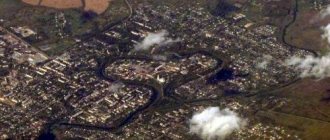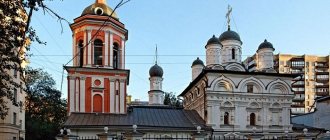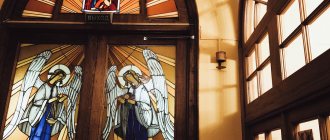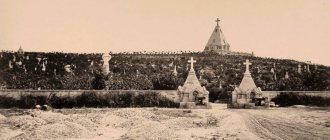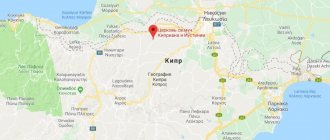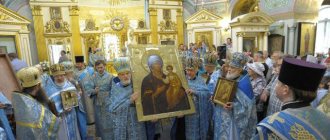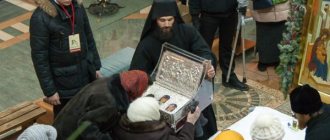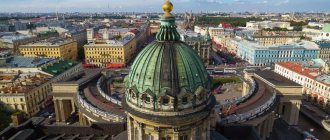Mir
Russia St. Petersburg Church of Rights. Job the Long-Suffering at Volkovskoye Cemetery (St. Petersburg) Map is loading...
{"format":"leaflet","minzoom":false,"maxzoom":false,"limit":50,"offset":0,"link":"all","sort":[""], "order":[],"headers":"show","mainlabel":"","intro":"","outro":"","searchlabel":"\u2026 \u0441\u043b\u0435\ u0434\u0443\u044e\u0449\u0438\u0435 \u0440\u0435\u0437\u0443\u043b\u044c\u0442\u0430\u0442\u044b","default":"","import-annotation":false,"width ":"auto","height":"350px","centre":{"text":"","title":"""link":"""lat":59.9006200000000035288394428789615631103515625,"lon": 30.35473999999999961119101499207317829132080078125,"icon":""},"title":"","label":"","icon":"","lines":[],"polygons":[],"circles":[ ],"rectangles":[],"copycoords":false,"static":false,"zoom":8,"defzoom":14,"layers":["OpenStreetMap"],"image layers":[] ,"overlays":[],"resizable":false,"fullscreen":true,"scrollwheelzoom":true,"cluster":false,"clustermaxzoom":9,"clusterzoomonclick":true,"clustermaxradius":80, "clusterspiderfy":true,"geojson":"","clicktarget":"","showtitle":true,"hidenamespace":false,"template":"","userparam":"","activeicon": "","pagelabel":false,"ajaxcoordproperty":"","ajaxquery":"","locations":[{"text":"\u003Cb\u003E\u003Ca href=\"/palomnik/%D0% A6%D0%B5%D1%80%D0%BA%D0%BE%D0%B2%D1%8C_%D0%BF%D1%80%D0%B0%D0%B2._%D0%98%D0% BE%D0%B2%D0%B0_%D0%9C%D0%BD%D0%BE%D0%B3%D0%BE%D1%81%D1%82%D1%80%D0%B0%D0%B4% D0%B0%D0%BB%D1%8C%D0%BD%D0%BE%D0%B3%D0%BE_%D0%BD%D0%B0_%D0%92%D0%BE%D0%BB%D0% BA%D0%BE%D0%B2%D1%81%D0%BA%D0%BE%D0%BC_%D0%BA%D0%BB%D0%B0%D0%B4%D0%B1%D0%B8% D1%89%D0%B5_(%D0%A1%D0%B0%D0%BD%D0%BA%D1%82-%D0%9F%D0%B5%D1%82%D0%B5%D1%80% D0%B1%D1%83%D1%80%D0%B3)\» title=\»\u0426\u0435\u0440\u043a\u043e\u0432\u044c \u043f\u0440\u0430\u0432. \u0418\u043e\u0432\u0430 \u041c\u043d\u043e\u0433\u043e\u0441\u0442\u0440\u0430\u0434\u0430\u043b\u044c\u043d\u043e\u0433\u 043e\u043d\u0430\u0412\u043e \u043b\u043a\u043e\u0432\u0441\u043a\u043e\u043c \u043a\u043b\u0430\u0434\u0431\u0438\u0449\u0435 (\u0421\u0430\u043d\u043a\ u0442-\u041f\u0435\u0442 \u0435\u0440\u0431\u0443\u0440\u0433)\»\u003E\u0426\u0435\u0440\u043a\u043e\u0432\u044c \u043f\u0440\u0430\u0432. \u0418\u043e\u0432\u0430 \u041c\u043d\u043e\u0433\u043e\u0441\u0442\u0440\u0430\u0434\u0430\u043b\u044c\u043d\u043e\u0433\u 043e\u043d\u0430\u0412\u043e \u043b\u043a\u043e\u0432\u0441\u043a\u043e\u043c \u043a\u043b\u0430\u0434\u0431\u0438\u0449\u0435 (\u0421\u0430\u043d\u043a\ u0442-\u041f\u0435\u0442 \u0435\u0440\u0431\u0443\u0440\u0433)\u003C/a\u003E\u003C/b\u003E\u003Chr /\u003E\u003Ca href=\"/palomnik/%D0%A1%D0%B2%D0% BE%D0%B9%D1%81%D1%82%D0%B2%D0%BE:%D0%90%D0%BD%D0%BD%D0%BE%D1%82%D0%B0%D1%86 %D0%B8%D1%8F\" title=\"\u0421\u0432\u043e\u0439\u0441\u0442\u0432\u043e:\u0410\u043d\u043d\u043e\u0442\u0430\u0446\u0438\u044f\ »\u003E\u0410\u043d\u043d\u043e\u0442\u0430\u0446\u0438\u044f\u003C/a\u003E: »'\u0426\u0435\u0440\u043a\u043e\u0432\u044c \ u0418\u043e\u0432 \u0430 \u041c\u043d\u043e\u0433\u043e\u0441\u0442\u0440\u0430\u0434\u0430\u043b\u044c\u043d\u043e\u0433\u043e"' \u2014 \u04 3e\u0434\u0438\u043d\u0438 \u0437 \u043d\u0435\u043c\u043d\u043e\u0433\u0438\u0445 \u043f\u0435\u0442\u0435\u0440\u0431\u0443\u0440\u0433\u0441\u043a\ u0438\u0445\u0445\u0440\u0430 \u043c\u043e\u0432, \u043d\u0435 \u0437\u0430\u043a\u0440\u044b\u0432\u0430\u0432\u0448\u0438\u0445\u0441\u044f \u0432 \u04 41\u043e\u0432\u0435\u0442\ u0441\u043a\u043e\u0435 \u0432\u0440\u0435\u043c\u044f","title":"\u0426\u0435\u0440\u043a\u043e\u0432\u044c \u043f\u0440\u0430\u0 432. \u0418\u043e\u0432\u0430 \u041c\u043d\u043e\u0433\u043e\u0441\u0442\u0440\u0430\u0434\u0430\u043b\u044c\u043d\u043e\u0433\u 043e\u043d\u0430\u0412\u043e \u043b\u043a\u043e\u0432\u0441\u043a\u043e\u043c \u043a\u043b\u0430\u0434\u0431\u0438\u0449\u0435 (\u0421\u0430\u043d\u043a\ u0442-\u041f\u0435\u0442 \u0435\u0440\u0431\u0443\u0440\u0433)","link":"","lat":59.9006200000000035288394428789615631103515625,"lon":30.354739999999999611191 01499207317829132080078125,"icon":""}],"imageLayers":[]}
59.900592; 30.354729
Russia, St. Petersburg, Kamchatskaya street, 6A
Saint Petersburg
Russia
Telephone.:
+7 (812) 766-25-44, 766-27-49, 766-22-58
Church of Job the Long-Suffering
- one of the few St. Petersburg churches that were not closed during Soviet times, even during the days of the blockade. A historical and architectural monument of federal significance, protected by the state.
History[edit]
This church is one of the most famous shrines of St. Petersburg, the only functioning temple of one of the largest necropolises of the northern capital, the Volkovo Orthodox cemetery.
Long before the founding of the city, in the salary book of the Vodskaya Pyatina of 1499-1500, the Setui River is mentioned, which during the time of Swedish rule in the 17th century. called Syutola (Sutilla), that is, Volkovka. The village with the same name, according to the scribe books of 1640, belonged to the Spassky Pogost.
In 1710, with the establishment of the Alexander Nevsky Monastery, Peter I transferred the surrounding land, including the village of Volkovo, into the ownership of the monastery. In 1714, along the Great Moscow Road, which ran along the route of what is now Ligovsky Prospekt, peasants from different provinces began to settle for postal purposes. They formed the Moscow Yamskaya Settlement, to which on December 6, 1723, Volkovo Field was assigned - a hummocky clearing overgrown with bushes and covered with a swamp.
During the reign of Elizabeth Petrovna, on May 11, 1756, by decree of the Senate, the Admiralty Side cemetery was built to replace the cemetery at the Church of St. John the Baptist. The latter was located too close to the city and interfered with the Empress’s walks along the Yamskaya Sloboda on Semik and Forgiveness Sunday.
On December 3, 1759, the first church built by the provincial office was consecrated in the name of the Savior Not Made by Hands. The small single-altar church, cramped and cold, did not meet the needs of the parishioners, and in 1776-1777. Through the diligence of the merchant Nikifor Shvetsov (Shevtsov), a warm wooden church was erected, consecrated in October 1777 in honor of the Renewal of the Church of the Resurrection of Christ in Jerusalem (Resurrection of the Word). The following year, 1782, it burned to the ground, and in the same year the clergyman actively began building a stone church in honor of the same holiday. On September 13, 1785, it was consecrated by one of the outstanding Russian hierarchs, Metropolitan Gabriel (Petrov). In the name of his heavenly patron St. In March 1793, the Archangel Gabriel was consecrated in the choir chapel above the porch of the Church of the Resurrection. It is assumed that the project could have been drawn up by the famous Russian architect, builder of the Holy Trinity Cathedral in the Lavra, I.G. Starov. In 1831-1834. architect A.F. Votskoy built a bell tower and erected a fence with a gate.
Over time, the Spasskaya Church fell into disrepair. In 1809, they decided to build a new temple, the design of which was drawn up by V.I. Beretti. However, the church was founded only in 1837 under Metropolitan Seraphim according to a simplified and significantly cheaper project by F.I. Rusko. The majestic three-altar church was consecrated on November 15, 1842 by the Exarch of Georgia, Metropolitan Jonah. Following his example, at the expense of the headman of the single parish, P.I. Ponomarev in 1850-1852. They built another one, the All Saints Church.
The only completely preserved church of St. Job, therefore, is the penultimate of the five churches of the Volkov cemetery.
At the beginning of the 20th century. Church of St. Job was often called “Kryukovskaya”. The popular name reflected gratitude to “the creators and benefactors of this holy temple” - the St. Petersburg Kryukov family. The initiative to build the temple belonged to Paraskeva Kryukova, the widow of the hereditary Honorary Citizen, merchant of the 1st guild Job Mikhailovich Kryukov (1816-1884), who lived in his own house on the Kadetskaya line of Vasilievsky Island No. 31. I.M. Kryukov was educated at home, was a member of the merchant class, and from 1859 was a member of the Commercial Court, elected from the merchant class. He had three sons - Gabriel, Mikhail and Nikolai and two daughters: Evdokia and Olga. Two daughters, Paraskeva and Vera, died in infancy. The Kryukovs, known for their charitable activities, were parishioners of the Church of St. Catherine on the Kadetskaya line. Kryukov died on May 19, 1884 and was buried at the Volkov cemetery. His widow and son turned to Metropolitan Isidore (Nikolsky) with a petition for permission to build a stone church over his grave, allocating 75,000 rubles for this and pledging to donate 12,500 rubles to the cemetery church for future maintenance in State Bank revenue tickets and the same amount as a fee for committing Liturgies on Mondays, Wednesdays and Saturdays. The Spiritual Consistory, the Holy Synod (August 28, 1885) and the Emperor (November 7) approved the project of the temple on the burial grounds purchased by the Kryukovs. On May 19, 1885, on the next anniversary of Kryukov’s death, a temple was founded in the name of the heavenly patron of the deceased. Thus, the church is a type of clergy temple-tomb, which is emphasized by its rare dedication. Within the modern borders of the St. Petersburg diocese and in the entire north-west of Russia there is only one church in the name of St. Job - cemetery in Tikhvin. The patron character of the temple may have been reflected by the placement in the iconostasis of the heavenly patrons of members of the Kryukov family, in particular, Sts. Martyrs Paraskeva and Evdokia, St. Olga, possibly St. Archangels Michael and Gabriel and St. Nicholas.
Construction and decoration were carried out at the expense of the Kryukov family. The temple was designed for 180 people, the choir for 40 people. Paintings with gilding were performed by I.T. Trifonov, as well as Butkov and Karuzin. In addition to wall paintings, Trifonov created local icons. The two-tier carved iconostasis was made by master P.S. Abrosimov. The consecration of the temple took place on October 29, 1887. The service was led by Metropolitan Isidor (Nikolsky) of St. Petersburg and Novgorod, Bishop Sergius of Ladoga and Archimandrite Nikon of the Alexander Nevsky Lavra. A memorial plaque under the throne has been preserved with the text: “This throne was approved at the expense of honorary citizen Paraskeva Mikhailovna Kryukova and consecrated on October 28, 1887.”
P.M. Kryukova and members of her family continued to patronize their parish church of St. Catherine. After the death of I.M. Kryukov, his trading business was continued by G.I. Kryukov, who joined the merchant class in 1885 and founded, merchant of the 1st guild, member of the St. Petersburg Commercial Court, for some time also owned a tavern at B. Sampsonievsky, 70. In December 1895, he died, probably not leaving direct descendants - two of his daughters died in infancy. Brothers Nikolai and Mikhail divided the business: Mikhail settled at Gagarinskaya, 12, where, having received a certificate of the 2nd guild back in 1893, he opened a trade at Panteleimonovskaya, 16; Nikolai left behind a store in Gostiny Dvor, but soon probably left the merchant class.
The entire basement floor of the church was occupied by the Kryukov family tomb. It contained 9 burials; here, in the vestibule, I.A. was buried. Aristarkhov. Nowadays, three slabs with the inscriptions have been preserved: 1) “Here is buried the body of an honorary hereditary citizen of the St. Petersburg 1st Guild of merchant Job Mikhailovich Kryukov. Born April 29, 1816. Died May 19, 1884”; 2) “Here lie the children of the hereditary honorary citizen Job Mikhailovich Kryukov: infants Paraskeva and Vera and the children of Gabriel Iovovich Kryukov: infants Peter and Alexandra”; 3) “The body of the hereditary honorary citizen Gabriel Iovovich Kryukov is buried here. Died December 3, 1895.”
Coincidence of the day of St. Job on the birthday of the last Russian emperor (May 6, Old Style) was the reason for the legend about a visit to the church of St. Tsar Nicholas with the August Family. In the pre-revolutionary period, irregular services were held in the church, mainly funeral services; while there was a single parish, they were constantly served only in the Spasskaya and Resurrection churches. After the revolution, agreements on the transfer of the church to believers were concluded in 1928, 1930, 1931 and 1932. In 1932-1933 Most of the bells were removed, and from July 1933 bell ringing was banned.
The authorities repeatedly put pressure on the parish. In particular, in 1931 it was proposed that the Spassky and Kryukovsky parishes merge with the closure of the second due to the “lack of the required number of members in the twenty.” But both parishes were then saved. On February 9, 1932, the regional commission on religious issues proposed closing and demolishing the Church of St. Job. On February 21, 1932, the Presidium of the Leningrad City Council decided: “Taking into account the demands of the workers expressed in the orders of the XII convocation of councils and taking into account that the building is subject to damage and that, as established by observations, church attendance is very insignificant, and since the building, according to the conclusions of the technical commission , cannot be rationally used for cultural, economic and other purposes, demolish the church, use the material for construction needs.”
However, the church was never closed and retained not only its decoration, icons, but also some utensils from other churches of the Volkovsky cemetery, closed by 1936 (no inventories have been found). By the mid-1930s. Church of St. Job occupied a special position among the churches of the “Tikhon orientation”, the parish of which remained faithful to the canonical church government. On February 13, 1935, 9 full-time and assigned priests and 5 deacons served at the Volkovsky cemetery. But during the mass expulsions and arrests in March-April 1935, after the murder of Kirov, almost half of the clergy were subjected to repression, and only three full-time priests and one deacon remained at the Volkovskoye cemetery. As of September 4, 1941, the church had two clergy on staff - Archpriest Mikhail Aleksandrovich Smirnov and Archpriest Evgeny Aleksandrovich Florovsky. In July 1941 - June 1945. Moreover, contributions were made to the Defense Fund (655 thousand rubles), in favor of the Red Cross Society (146 thousand rubles), for gifts to soldiers (80 thousand rubles) and to the Fund for Assistance to Military Families (150 thousand rubles). ).
The losses of the monument are numerous: a number of icons and church utensils were confiscated in the 1920s, as well as the loss of a number of burials in the tomb. Until 1934, part of the frame of the window opening in the 1st tier of the bell tower, which had previously been a keel-shaped kokoshnik, disappeared.
On August 13, 1976, the throne was consecrated in honor of the Image of the Savior Not Made by Hands and in memory of the cemetery's Spassky Cathedral, closed in 1936. The rite was performed by the vicar Archbishop of Tikhvin Meliton (Soloviev). Among those who served was Hieromonk Methodius (Nemtsov), now Metropolitan of Voronezh and Lipetsk. The chapel is sometimes incorrectly designated as St. Artemievsky, since the Metropolitan donated a particle of the relics of St. Vmch. Artemia, enclosed in the throne. An interesting antimension of the temple with a tetragram of the Name of God, consecrated by Archbishop of Pskov and Narva Stefan (Kalinovsky) on May 29, 1744 in the chapel of St. Alexy the man of God, famous for its architecture, the Pskov Church of St. Vasily "on the hill". On the lower field is the signature “Humble Simon, Bishop of Pskov and Narva.” The Reverend Simon (Todorsky), teacher of the law to Peter III and Catherine II, took the Pskov See in 1745. On the outside of the same antimension there is an inscription: “This holy antimension is handed over for sacred rites in the chapel of the cemetery church of the Volkov cemetery in honor of the Image of the Savior Not Made by Hands in the city of Leningrad . By the grace of God, humble Gregory, Metropolitan of Leningrad and Novgorod. January 5, 1950." Probably, already under Vladyka Gregory (Chukov) the construction and consecration of the lower church was planned, but it dragged on for 16 years.
The antimension on the side altar in the main altar has on the lower vignette the text of 1928: “Consecrated by the Most Reverend Leonid, Bishop of Pereyaslavl, vicar of the Vladimir diocese in the summer of the creation of the world (7837) from the Nativity of Christ 1928, October 28th day.” His Eminence Leonid (Antonishchenko), organizer of the metochion of the Beijing Ecclesiastical Mission in St. Petersburg, died in exile in 1937. On the outside there is an inscription: “This holy antimension is taught for sacred rites on a portable altar in the church of St. right Job at the Volkov cemetery in Leningrad. By the grace of God, humble Gregory, Metropolitan of Leningrad and Novgorod, April 16, 1954.” Early liturgies are usually celebrated on the side altar.
Repair and restoration work carried out in the mid-1980s included updating the wall paintings and repairing the former tomb under the upper altar with the construction of a spiral staircase from the sacristy. An office building was set up here. In 1996, the facades were repaired.
Architect, exterior decoration, architectural ensemble
The temple in honor of St. Job in Kuntsevo was built according to the design of the famous architect Andrei Nikolaevich Obolensky in the Orthodox world. Under the leadership of the Moscow artist Olga Valerievna Syuskova, the interior was designed and the interior and exterior decorations were created.
The church ensemble includes a snow-white stone church in honor of the first Patriarch of Christian Rus', a small wooden building of the Church of the Moscow Saints and a clergy house. The main temple with one limit can accommodate up to 300 worshipers at a time. It is crowned with a dome with a large gilded cross above a beautiful hipped roof with carved valances.
The façade of the building is decorated with stone decor and several colored mosaic icons, which were created using a special technology using stone fragments. Stone balustrades lead into the temple. The basement is used for baptismal ceremonies. A large area around the church complex is fenced and landscaped.
Current state[edit]
Church of St. Job is part of the historical ensemble of five churches of the Volkov cemetery (three have survived). All of them were built in various modifications of the Russian style (except Voskresenskaya). Church of St. Job is located at a distance from the modern entrance to the museumized part of the Literary Bridges cemetery. Unfortunately, the direct approach to the church from Kamchatskaya Street is now blocked.
Near the northwestern corner there is a chapel - a tomb of the second half of the 19th - early 19th century. XX century with a tent roof, funeral services are now held in it. With the blessing of Metropolitan Vladimir of St. Petersburg and Ladoga and through the efforts of the rector of the church, the dean of the Yamburg district, Archpriest Leonid Stepanov, significant repair and restoration work was carried out in 2001, including the restoration of the lower church.
The architecture of the temple corresponds to the tradition of the Russian style, which spread in the church architecture of the empire since the 1830s. Masters of the Russian style sought to revive the national architectural tradition, largely lost since the era of Peter the Great's reforms, and were guided by monuments of ancient Russian architecture. In the field of architecture, the Russian style visibly embodied the unity of the Orthodox Church, autocratic power and national principles. The Russian style was very closely adopted by customers, primarily the emperor, and dominated Orthodox church construction in the Russian Empire from the 1830s. before the cessation of temple construction after the coup of 1917 (whether construction was based on “author’s” or standard designs), thereby being one of the most important evidence of the spiritual life of the Russian people. The founder of the new direction was academician, professor of architecture K.A. Tone, after which the first stage of the Russian style is often called “Tonovsky”. Its prototypes are examples of early Moscow architecture (XV-XVI centuries). K. Thon revived the special significance of temple design, as it was in the Middle Ages; and his significance in the creation of the Russian architectural language was compared by his contemporaries with the significance of Pushkin in Russian literature. Tonov's model designs, published in the capital in 1838 and 1844, were officially recommended for new church construction and were widely used.
Composition of the Church of St. Job corresponds to the albums of K.A. Ton and the traditional three-part scheme for Russian architecture: a central quadrangle, completed with a five-domed structure, with an adjacent altar part, a refectory and a hipped bell tower above the vestibule. The decorative decoration of the church is focused on the traditions of Moscow and Yaroslavl architecture and gravitates towards monuments of the second - “Romanov” stage of the development of the Russian style, which reached its peak in the 1880-1890s. — bulbous five-domed structure, kokoshniks, tent, flies. The “Moscow-Yaroslavl” or “Romanov” style began to spread in the 1870s. and was distinguished by special attention to decor in the spirit of the 17th century. It received a more organic embodiment during the construction of small churches, such as the Church of St. Job.
The main quadrangle is completed with five chapters (the central one is light) on a pedestal. The rectangular altar apse is adjacent to the low volumes of the sacristy (from the south) and the vestibule with an entrance for clergy (from the north). In the lower tier of the bell tower there are stairs to the bell tower (from the north) and to the lower temple (from the south). The walls of the church are plastered and painted yellow, the elements of architectural decor are whitewashed. The church has a high base, the lower part of which is lined with Putilov slabs. The decorative decoration of the quadrangle consists of blades, the corners of which are highlighted by columns. In the center of the side facades there are two narrow, paired, arched windows framed by pilasters and semi-circular kokoshniks. The arched windows of the refectory (one each on the side facades) are framed by pilasters on which triangular sandriks rest. The two central kokoshniks are three-part. The central drum is larger than the corner ones, decorated with kokoshniks and a columnar belt in which arched windows are cut. The bulbous domes are painted green, the openwork six-pointed crosses are gilded. The walls of the altar are also decorated with pilasters and kokoshniks. In the icon case there is a majolica image of the Mother of God with the Divine Child, made in 1994.
The western façade is decorated with columns in the corners and a high triangular gable pediment above the entrance vestibule. The side parts of the narthex from 1994-1995. decorated with rectangular icons depicting St. Job with a scroll on which the words: “God gave, God has taken” (left), and the Savior (right). The base of the bell tier rises above the roof of the vestibule. On the sides of the window there are rectangular flies. The octagonal tier of the bell is cut through by arches at the cardinal points; the diagonal edges are decorated with paired pilasters with capitals; at the end of each face there is a keel-shaped kokoshnik. The bell tower is topped with an octagonal tent with rectangular finials framed by columns and topped with keeled kokoshniks. The octagonal drum above the tent is crowned with a bulbous dome.
Currently the church is two-story. The upper temple has a “Latin cross” in plan. Massive pylons with chamfered corners support a central sail vault with box arches at the base. The panels of the pylons and the soffits of the arches have a picturesque ornament in the Russian-Byzantine style. The walls are partially painted in oil with images from the Gospel (on the left - “The Trial of Pilate”, on the right - “The Betrayal of Judas”); cloudy vault of heaven (in the altar), four Evangelists (sails of the vault), St. Moscow Peter, Philip, Jonah, Alexy. At the base of the light drum there are life-size figures of eight saints (from the west - Apostle Andrew, Archdeacon Stephen, Apostle Thomas, Philip, the prophets David, Moses, Isaiah and Ezekiel). The style of the paintings is close to late academicism. In the center of the flat ceiling of the drum is an image of the Savior Emmanuel with a radiance surrounded by cherubs. In the arch above the altar there is an inscription: “Who is the great God...”, in the drum - “Glory to God in the Highest...”, in the arch above the porch - “I will enter Your House.” The two-tier iconostasis of the main temple is made in the Russian style of the 17th century, richly decorated with gilded carvings and edging. In front of it is a three-stage soleya with two pairs of carved icon cases on the sides, a soleya fence made of cast rods with applied four-pointed crosses. In the western part of the narthex there are choirs with a wooden balustrade. A massive two-tier chandelier has been preserved in the church.
The recognition of the artistic merits of the temple's architecture is evidenced by the fact that when designing a new church in the cemetery - the Kolobov tomb (1901) - civil engineer L.V. Schmelling reproduced Aristarkhov's type of construction without any special changes. Church of St. Job is one of the most characteristic examples of church architecture of St. Petersburg in the Russian style, a monument of history and culture of federal significance in accordance with the decisions of the Small Council of the St. Petersburg City Council of People's Deputies No. 327 of September 7, 1993 and Decree of the President of the Russian Federation No. 176 of 20 February 1995. This is the only surviving church building by the architect Aristarkhov, one of the few churches in which prayer never stopped.
Temple of Job of Moscow on Mozhaika today
The Church of Job of Moscow on Mozhaika has the official name “Church of St. Job the Patriarch of Moscow and All Rus' in Kuntsevo.” The Patriarchal Metochion of the Holy Dormition Monastery in Staritsa. Between him and the monastery in the Tver region there are inextricable spiritual bonds that justify the legitimacy of the location of the Patriarchal courtyard of the temple away from it.
Moscow and the Staritsa in the life of Job
In Moscow, Job carried out patriarchal service, and in Staritsa the future Patriarch was born and took monastic vows at the Holy Dormition Monastery. During the time of unrest, supporters of False Dmitry I expelled Job from his patriarchal throne and imprisoned him in the Assumption Monastery, since he did not recognize the self-proclaimed king and even anathematized him.
After the overthrow of False Dmitry I, the sick Great Martyr Job, who had completely lost his sight, returned to Moscow and blessed Metropolitan Hermogenes for patriarchal service. Returning to the monastery, Saint Job, after a long illness, ended his worldly journey and was buried on the monastery territory.
Currently, the incorruptible relics of the first Patriarch are in the patriarchal tomb of the Moscow Kremlin, where they were placed in the middle of the 17th century.
400th anniversary of the establishment of the Patriarchate in Rus'
The construction of the Temple of Job on Mozhaika in Moscow took place in the new, independent Russia. This event is directly related to the anniversary celebration in 1989 of the 400th anniversary of the establishment of the Patriarchate and the canonization of Job.
Job, Patriarch of Moscow and All Rus'
The merits of Patriarch Job are difficult to overestimate. Under him, the Moscow Patriarchate expanded due to several annexed metropolises and new established dioceses, and new churches and monasteries were actively built. He invested his own money in the creation of some of them.
Saint Job achieved the canonization of St. Basil and other saints, thanks to him the Russian Orthodox Church became independent of Constantinople.
Shrines[edit]
Among those now venerated in the church, St. Job's shrines: icons of the Mother of God Quick to Hear (in front of the left choir) and “Do not weep for Me, Mother” (in front of the right choir), the Image of the Savior Not Made by Hands, the image of Sts. Nicholas the Wonderworker, Job and Panteleimon in the “Vasnetsov” style. On the frame of the image of St. Nicholas - the inscription: “This robe was composed with special money through the diligence and care of Captain Pamenbach, second lieutenant of Prince Ivan Shcherbatov. June 12, 1744." It is impossible to exclude the origin of the ancient image of the Savior Not Made by Hands (circa 16th-17th centuries) from the now destroyed Annunciation Edinoverie Church at the Volkov Cemetery or the Spassky Cathedral. The large icons depicting the appearance of the Lord to St. that were originally in the temple have been preserved. Job (Job. 42, 5-6), the appearance of the Mother of God, St. Sergius of Radonezh, St. John Chrysostom, healing a demon-possessed youth, praying to St. Gregory the Theologian and serving the liturgy of St. Basil the Great. The Feodorovskaya Icon of the Mother of God (at the entrance on the left) has the signature of the famous master Vasily Peshekhonov (1882). Among other images of the upper church is the icon of the Savior Pantocrator, donated by the society of artisans in 1782; Apostle John the Theologian (XVIII century), all saints, Protection of the Mother of God, St. vlmch. St. George the Victorious (in the transepts); Mother of God of Kazan, Joy of All Who Sorrow (XVIII century) and St. Petersburg; Savior Almighty and the Dormition (south wall); Mother of God of Tikhvin, Vladimir (XVIII century), Merciful, etc. "Vasnetsovskaya"; St. John the Baptist (XVIII century) and Nicholas the Wonderworker (XVII-XVIII centuries).
In the western part of the temple above the choir there are icons-paintings “Christ and the Samaritan Woman”, in the central transept on supporting pylons - “Transfiguration”; The Intercession (left), the Mother of God “Joy of All Who Sorrow” and the Presentation (right) in three-part wooden carved icon cases completed with three-bladed kokoshniks.
In the first row of the main iconostasis (from left to right) are the icons of the Introduction, St. Nicholas, Archangel Gabriel, Mother of God, Savior, St. Job, Archangel Michael, Exaltation. In the second - St. book Olga and MC. Lydia, mcc. Catherine and Barbara, app. Peter and Paul, Sts. John the Baptist and the prophet Isaiah, great martyr. Panteleimon and St. Alexander Nevsky, martyr. Paraskeva and prpmts. Evdokia. The third row consists of the image “Trinity of the New Testament” (“Fatherland”).
In the lower church there are three revered icons of the Tikhvin Mother of God (XVII-XVIII centuries), the Presentation of the Lord (ancient writing), etc. Varlaam of Kiev-Pechersk with a particle of his relics, Crucifixion; as well as the Kazan Mother of God (XVIII century), St. Nicholas the Wonderworker, Tsar Constantine and St. Seraphim of Sarov.
History of construction
The Temple of Job of Moscow on Mozhaika was included in the Program for the construction of 200 Orthodox churches in Moscow. The location for its construction is symbolic: to the west of Moscow is Staritsa, where Job, unjustly deposed from the patriarchal throne, was sent into monastic exile.
The microdistrict where the construction of the temple was planned had a reputation as socially disadvantaged. After bankruptcy and the closure of several factories in the 90s, local residents were left without work and their families without a livelihood. Banditry, drunkenness, prostitution flourished, and many drug addicts appeared.
The construction of the temple was a labor of love, and the people accepted it with enthusiasm. Activists helped prepare and clear the territory of the future church from debris; with their help, a small wooden church with 40 seats was built in 2012.
The main work on the construction of the stone building of the future church was carried out in a short time from 2012 to 2014. At the end of 2013, almost 12 months after laying the foundation stone of the temple, the Christian Symbol of Salvation - a shining gold Cross - was raised above the building standing in the woods .
In March 2021, after several years spent on decoration and decoration, a long-awaited event took place - the consecration of a new temple by Patriarch Kirill of Moscow and All Rus'. The temple has become a monument of modern church architecture, embodying the centuries-old traditions and culture of Russian Orthodoxy.
Schedule of services[edit]
Divine services are held daily.
Confession: weekdays at 8:30; on Sundays and holidays at 7:00 and 9:00.
Liturgy: on weekdays at 9:00; on Sundays and holidays at 7:00 and 10:00; the day before, during the All-Night Vigil, confession is held.
Akathists at 18:00: on Sundays - to the Savior; on Mondays - New Martyrs and Confessors of Russia; on Tuesdays - the Mother of God; Wednesdays - St. Nicholas the Wonderworker; on Thursdays - St. right Job. On Fridays at 18:00 - parastas.
Interior decoration
The small interior church space looks very solemn and cozy at the same time. A very beautiful 3-tier carved iconostasis contains icons of all saints and the main faces of the Virgin Mary. For the holidays, everything here is decorated with fresh flowers.
Beautiful candlesticks and an unusually shaped chandelier illuminate the interior of the temple with soft light. Everything here encourages thinking about the eternal and promotes peace.
Clergy, mentors
The Church of St. Job is served by a rector and two full-time clergy:
- Father Narushev Alexander is the rector of the temple . He is a candidate of theology, was ordained as a deacon in 2001 and as a presbyter in 2005, and has several liturgical and church awards.
- Alexander Kopyatkevich, priest , is a full-time clergyman, has a higher spiritual education, ordained to the rank of deacon in 2001, then 14 years later to the rank of priest. Has hierarchical and church awards.
- Anatoly Pravdolyubov is a hereditary priest , a full-time cleric with a higher education. He was ordained to the rank of deacon in 2014, to the rank of priest in 2021, and awarded hierarchical insignia.
Sunday School
The parish Sunday school opened immediately after the consecration of a temporary wooden church on the territory of the Church of Job of Moscow, which was under construction. After the service, benches were placed in the church building for children, and adults could be nearby. After the building of the Parish House was commissioned, classes were allocated for the Sunday School.
Classes for children from preschool age to 13 years are conducted free of charge by experienced teachers-mentors on Saturdays and Sundays. Children study the Law of God, the Church Slavonic language, the Old and New Testaments, and the liturgical charter for 4 years.
In addition to classes and hobby groups, students go on excursions, meet interesting people, take part in divine services and children's religious processions. There have already been 4 graduations of Sunday School students. It is led by the spiritual director, rector of the Church of Job, Priest Alexander Narushev.
You can register your child for Sunday School by calling. 8 916 123 26 53 or on the temple website. For adults, conversations on religious topics are held on Saturdays.
Parish and choir of the temple
The Church of Job of Moscow on Mozhaika unites parishioners of different nationalities. This is due to the fact that apartments in this microdistrict are rented by people who came to the capital of the Russian Federation to earn money from Ukraine, Moldova, Armenia, and Georgia. The parish at the Church of Job of Moscow was formed by local residents immediately after the news of the construction of the temple.
The parishioners took an active part in preparing the area for construction; with their help, a wooden chapel was erected, which became a temporary temple. Currently, a parish wall newspaper is published, the youth club “Candle” operates on Sundays, and active daily life is conducted in the parish house.
Interior decoration of the Temple of Job of Moscow on Mozhaika
The parish choir consists of 20 adults and children. It was created in September 2014 on the basis of the Sunday School. Many singers do not have a musical education, but they strive to serve God and are conscientious about practicing music and singing.
Choir rehearsals are held on Wednesdays and Saturdays, and training is free. Registration for auditions of those wishing to sing in a church choir is accepted by phone. The group of singers is led by regent Sofia Yuryevna Starostina.
Social work, everyday life
Parishioners, under the guidance of church mentors, engage in social work. At the temple for more than 5 years there has been a family sobriety club “Sretenie” , whose members gather once a week, in a friendly atmosphere during tea drinking they discuss problems with alcohol abuse that have arisen in families, and learn to create a sobriety territory at home.
Parishioners and clergy work with people addicted to alcohol and drugs and their environment according to the “12 steps” system. At the temple there is a room for mothers and children, where a woman with a child running away from her family from her drunken husband can come at any time of the day.
The volunteer group “Mercy” delivers gifts and congratulations to elderly people for the holidays, and takes care of large and low-income families.
Where is it located, what is in the surrounding area, how to get there
The Church of St. Job is located in the capital's Kuntsevo microdistrict on Mozhaiskoe Highway, 56. Public transport stop is the Minsk cinema, the nearest metro station is Molodezhnaya. Temple coordinates: 55.71704, 37.399461.
Tel.. Website: svt-iov_ru.
The Church of Job of Moscow on the Mozhaiskoye Highway in Kuntsevo (Moscow) is a tribute to the memory of the first Patriarch of Moscow and All Rus', Saint Job, who dedicated his life to serving God. Orthodox Rus' remembers and sacredly honors Christian traditions. This is its strength, this determines its leading position in the world in their conservation.
Author: Lyudmila Dmitrova
Information for pilgrims
Pilgrimage tours from Moscow to the holy places of Europe and Russia are organized by several travel agencies:
- Center for International Pilgrimage "Pokrov": schedule of pilgrimage tours on the website ps.pokrov-ru, phone number for inquiries +7;. The cost of the trip is from 1700 rubles.
- Tour operator “To the Origins”: schedule of pilgrimage trips on the website rosistok-ru, phone number for inquiries; +7.
- Pilgrimage service “Makovec”: schedule on the website makovec.hs-ru, tel. Reference.
Pilgrimage trips are also organized by the social service of the Church of St. Job. Last October, elderly parishioners visited the Compound of the Holy Dormition Monastery in Staritsa, then took excursions to the Pushkin Museum in Bernovo, the Church of the Transfiguration of the Lord and the holy spring in the village of Maslovo.
The pilgrims were provided with transport, 3 meals a day and overnight accommodation during the trip. The plan for pilgrimage trips for parishioners of the Church of Job in Moscow for 2021 is under development.


